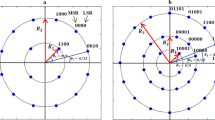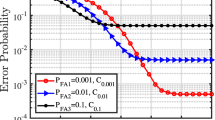Abstract
Blind equalization can be combined with soft-input decoders to greatly improve the performance of communication system. However, most blind equalization algorithms are not designed to provide posterior probability, which is essential for soft-input decoders. In this paper, blind equalization based on Gaussian process for classification (GPC), which could output such information, is applied to optimally detect the constant modulus signals. The scheme is implemented by automatically selecting proper initial training data set and continuously incorporating more appropriate points into training data set with a iteration process. During the iteration process, we utilize all equalizer input symbols that can be assumed to be a certain class label at a high probability as training data to make prediction with GPC model, and give out posterior probability of each input symbol under a specific class label. The proposed blind equalizer has been proved to be able to provide a better performance in both linear channel and nonlinear channel compared with other blind equalizers.






Similar content being viewed by others
References
Chen, S., Gunn, S. R., & Harris, C. J. (2001). The relevance vector machine technique for channel equalization application. IEEE Transactions on Neural Networks, 12(6), 1529–1532.
Guo, Y., Li, B., & Fan, K. (2012). Support vector machine wavelet blind equalization algorithm based on improved genetic algorithm. In Advances in electronic commerce, web application and communication (pp. 161–166). Berlin: Springer.
Hwang, K., & Choi, S. (2008). Blind equalization method based on sparse Bayesian learning. IEEE Signal Processing Letters, 16(4), 658–662.
Hwang, K., & Choi, S. (2012). Blind equalizer for constant-modulus signals based on Gaussian process regression. Signal Processing, 92(6), 1397–1403.
Kaya, I., Tugcu, E., Ozen, A., & Nix, A. (2015). Fast convergence algorithm for blind channel estimation and equalization using CMF-DFE. In Vehicular technology conference.
Kwok, J. Y. (1999). Moderating the outputs of support vector machine classifiers. IEEE Transactions on Neural Networks, 10(5), 1018–1031.
Olmos, P. M., & Rez-Cruz, F. (2010). Joint nonlinear channel equalization and soft LDPC decoding with Gaussian processes. IEEE Transactions on Signal Processing, 58(3), 1183–1192.
Perez-Cruz, F., Martinez-Olmos, P., & Murillo-Fuentes, J. J. (2007). Accurate posterior probability estimates for channel equalization using Gaussian processes for classification. In IEEE workshop on signal processing advances in wireless communications (pp. 1–5).
Santamaría, I., Pantaleón, C., Vielva, L., & Ibáñez, J. (2004). Blind equalization of constant modulus signals using support vector machines. IEEE Transactions on Signal Processing, 52(6), 1773–1782.
Silva, M. T. M., & Arenas-Garcia, J. (2013). A soft-switching blind equalization scheme via convex combination of adaptive filters. IEEE Transactions on Signal Processing, 61(5), 1171–1182.
Sun, Y., Liang, Z., & Jia, C. (2015). A fast converge momentum dual-mode modified constant modulus blind equalization algorithm for high-order qam signals. Wireless Personal Communications, 83(4), 1–11.
Thaiupathump, T., He, L., & Kassam, S. A. (2006). Square contour algorithm for blind equalization of qam signals. Signal Processing, 86(11), 3357–3370.
Williams, C. K., & Rasmussen, C. E. (2006). Gaussian processes for machine learning (Vol. 2, No. 3, p. 4). Cambridge: MIT Press.
Xiao, Y., & Yin, Fl. (2014). Blind equalization based on RLS algorithm using adaptive forgetting factor for underwater acoustic channel. China Ocean Engineering, 28(3), 401–408.
Xie, N., Hu, H., & Wang, H. (2012). A new hybrid blind equalization algorithm with steady-state performance analysis. Digital Signal Processing, 22(22), 233–237.
Yang, D., Chen, D., & Kuang, W. (2013). Constant modulus blind equalization analysis for high speed implementation. Berlin: Springer.
Yao, H., Zhang, S., & Wang, Z. (2011). Blind equalization algorithm based on least squares support vector regressor. In International conference on electronic and mechanical engineering and information technology, Emeit 2011, Harbin, Heilongjiang, China, 12–14 August, pp. 2675–2678.
Yasin, M., & Hussain, M. J. (2016). A novel adaptive algorithm addresses potential problems of blind algorithm. International Journal of Antennas and Propagation. doi:10.1155/2016/5983924.
Zen, A., Kaya, I., & Soysal, B. (2012). A supervised constant modulus algorithm for blind equalization. Wireless Personal Communications, 62(1), 151–166.
Acknowledgements
This work was partly supported by the National Natural Science Foundation of China under Nos. 61401090, 61574035, 61550110244 and 11301074.
Author information
Authors and Affiliations
Corresponding author
Rights and permissions
About this article
Cite this article
Sun, Z., Chen, T., Tong, Y. et al. Blind Equalization of Constant Modulus Signals Based on Gaussian Process for Classification. Wireless Pers Commun 97, 6005–6018 (2017). https://doi.org/10.1007/s11277-017-4824-9
Published:
Issue Date:
DOI: https://doi.org/10.1007/s11277-017-4824-9




